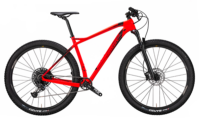Where and How to Buy a Bike Online Safely

A pre-assembled bicycle by Tommaso Cycling
Ordering a new bicycle through an online bike store has quite a few considerably important advantages. Although, there are still many of us who feel slightly overwhelmed by the whole process, and tend to prefer the local bike store.
Down here we will explore some of the pros and cons associated with online bike shopping and go over some of the steps to take to ensure that you get it right.
Why You Should Buy a Bicycle Online
Buying a bicycle online has several benefits, including convenience, extra time to make a decision, and a wider selection to choose from. It’s clear that seasoned cyclists have their own preferences, whether a certain bike type or a brand that is not represented at the local bike store.
- Convenience
The number one advantage of online shopping is the convenience – you can do it from home, on your phone, in bed, or wherever you like. With improved security and tons of online payment apps, online shopping is now easier than ever. - Less pressure
Unlike in physical stores, online you have less pressure to make a purchase and more time to investigate the product and make up your mind. Virtual sales reps may offer advice but they seldom try to force a product on you. - Wider variety
Physical shops have limited space to keep stock, so the selection of bikes on offer will be reduced. When shopping online, you should have access to any bicycle that you want – so long as the manufacturer is still making it. - Can be shipped anywhere
Most online retailers will ship products to almost anywhere in the world. Even with the added delivery costs, many online products usually work out cheaper than in stores. To save even more money, you can collect a delivery from your local REI store. - You can read the actual reviews!
One of the most underrated factors is getting feedback from the bike owners themselves.
Related posts:
Buying a Bike – Should You Pay More Upfront or Upgrade Later?
What is the real cost of a bicycle?
Some Drawbacks of Buying a Bike Online
However, there are also several pitfalls to buying a bike online, most notably the inability to test the product first. Unless you know exactly what you want and the correct size, you might end up with a very different bike from what you expected.
- Home assembly
In most cases, bicycles can’t be delivered fully assembled and require you to put them together at home. Often, this is simply a case of putting on the wheels and pedals with basic tools. However, in some cases, you may need special tools and a bit of mechanical experience.
For example, online bike stores such as Aventuron and Tommaso Cycling offer a solution to ship a pre-assembled bike, whereas all the ‘break-in’ tuning has been done for you!
- Unable to test the bike
If you aren’t certain what bike you want, you’ll want to test ride it first to get the feel and size right. Only highly-experienced cyclists will know exactly what they are looking for in a bike and the correct size for them. Not all bike frames are built identical, so if you currently have a 52cm frame it doesn’t necessarily mean your new bike should have one too. - Warranty and repairs
If any part of the bike is damaged in transit, you’ll have to return and hope the cost is covered by a warranty. This can take time and, in some cases, cost extra. If you buy from a local bike store, they almost always fix any issues quickly and free of charge.
In other words, in case something on the bike happens to breaks before the normal wear and tear – it could be a little painful process to ship
- Not supporting local business
Online shopping has long been criticized for driving out local businesses that can’t compete with the cheap prices. This brings down the overall value of your neighborhood as shops close and people end up out of work.
If you receive a bicycle that’s mostly uninstalled, you can support your local bike store by bringing the bike in for installment, or a tune-up after the break-in time (Generally around 20-50miles)
How to Choose the Right Bike to Buy?

- Choose the right type of bike
- Look up the correct size – which one’s more important – the height range or the inseam
- Choose a brand & model
Which Type of Bike To Buy?
Whether you are looking for a city-, electric- or a mountain bike, take your time to figure out where and how often will you be using the bike most. Each type of bike has its own advantages and disadvantages for different occasions of use.
Related: 16 Different Types of Bikes
Check out our Best-Of-Reviews
- Hybrid – Best for urban commuting with a slight capability to turn down the trails
- Mountain – Built for the trails while can be used comfortably for everyday commutes through mixed terrains
- Road – Performance-orientated two-wheelers
- Electric – For everyone who’s looking for a silent alternative to motorized transportation
- Fat Bikes – Sand, snow, trails
- Gravel Bikes – A sporty mixture between a road and a mountain bike
Getting the size right
It’s vitally important to get the size right on your bike otherwise you could end up injuring yourself by riding incorrectly for long periods of time.
Height is the most common metric used to decide which frame size is correct but it is important to also fit the bike properly. This involves measuring your ‘inseam’ and ‘reach’ in order to correctly set the saddle position along with the handlebar height and angle.
Bike Size Charts – How to Choose the Right Bicycle Size
Depending on the style of cycling you plan to do, these settings will be different for each person and bike. Commuter and touring bikes require a more upright position for long-distance comfort, whereas road bikes require a bent-forward position for aerodynamics and speed.
Order Process
Ordering a bike online is relatively straightforward.
Once you’ve made your selection, simply choose the delivery method and enter your address details. In some cases, you’ll have the option to pay extra for quicker delivery, or extra insurance.
On the next page, ensure the cost and delivery details are correct before selecting a payment method. A credit card is the most common payment method, with some retailers also offering Paypal or similar.
Once complete, you should receive a confirmation email with all the details and a link to track your order progress. Now all you’ve got to do is wait for your new bike to arrive.
Bike Assembly Upon Arrival
Some stores offer to pre-assemble online bikes before delivery at extra cost but in most cases, you’ll likely have to do some assembly at home. In many cases, this could be as simple as slipping on the front wheel and straightening the handlebars.
However, it’s not uncommon for bikes to arrive completely unassembled. If you don’t have the tools and know-how to assemble a bike, make sure to first check with the retailer regarding assembly. Some bikes may come with the necessary tools for assembly.
If your bike does arrive unassembled, you may need a variety of simple tools including Allen keys, spanners, screwdrivers, Torx wrench, and a tire pump. Usually, complex systems like the fork, brakes, bottom bracket, and cassette will already be attached.
Don’t forget to tune your bike after a while – it is a crucial step many will fail!
Setting Up
Attaching the seat post, saddle, handlebars, and wheels are usually simple enough but must be done correctly. The seat post and handlebars usually attach with a simple Allen key and will require some adjustment to get the right position.
The crankset requires a ratchet or socket wrench and spanner for the pedals. It can be a bit confusing as on one side you will need to tighten them in an anti-clockwise direction. Wheels usually slip in easily and are tightened with a quick-release skewer or simple nut and bolt.
Break-In Period
Once assembled, take the bike for a careful ride around your garden or on the sidewalk to ensure everything is in place. You’ll likely have to do some adjustments and tighten until everything is fitted correctly.
New Bike Buying – Importance of Break-in Period – Check-Up, Tune-up
Be sure to check the terms of your warranty and test the bike fully in the days after receiving it. Often you’ll only have 7 days to return the bike if you are unhappy with it, although some warranties have a 30-day return period.
Register Your Bike
In order to receive a full warranty on the frame and components, make sure to register your bike as soon as possible. Even though you did not buy it from the store – the warranty aspect stays the same.
Conclusion
Online bicycle shopping certainly removes some of the stresses involved with heading out to a busy shopping center and dealing with pushy sales reps. It’s usually the best way to get the cheapest deals as you can shop around more and compare prices easily. However, it also comes with its own set of hurdles that could cause trouble down the line if not addressed properly.
Without the assistance of a sales rep, you’ll need to do your own research to find out which bike is correct for you. You’ll also need to measure your height, inseam, and reach to estimate which size will fit you best.
These are important considerations that should not be overlooked when shopping for a bike online. Always read the terms and conditions and check the warranty before making a purchase.
Good luck!





